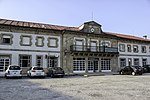As Burgas
Galician cultureGeography of the Province of OurenseHot springsOurense

As Burgas are hot springs in the historic center of Ourense, in Galicia, Spain. They include Burga do Medio, which is infused with gas, Burga de Arriba and a Burga de Abaixo. The waters are similar to those of Carlsbad, and gush from granite rock to the west of the town at almost the boiling point. The hot mineral waters gush at 80 gallons per minute.
Excerpt from the Wikipedia article As Burgas (License: CC BY-SA 3.0, Authors, Images).As Burgas
Rúa das Burgas, Ourense Casco Vello
Geographical coordinates (GPS) Address Nearby Places Show on map
Geographical coordinates (GPS)
| Latitude | Longitude |
|---|---|
| N 42.3347 ° | E -7.865 ° |
Address
Rúa das Burgas 12
32005 Ourense, Casco Vello
Galicia, Spain
Open on Google Maps








